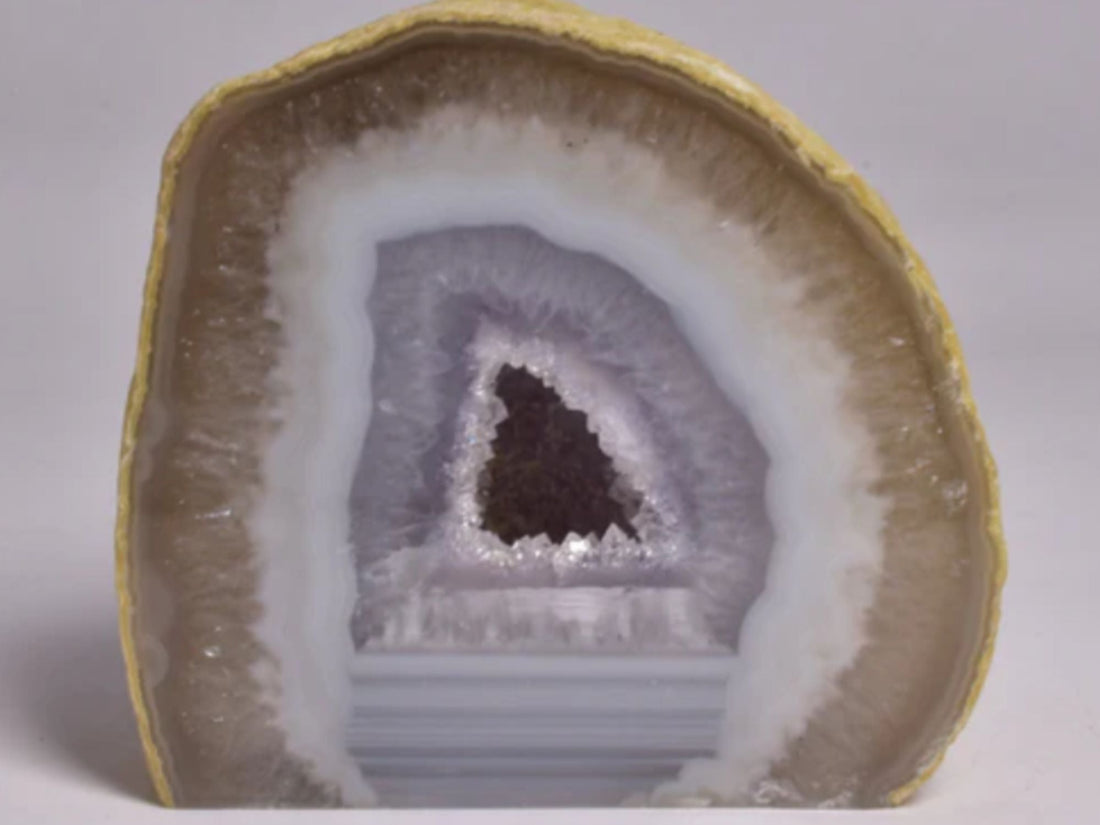
Agate: Mineralogical Properties and Formation Mechanisms
Share
View And Shop Our Agate Collection
Agate is a cryptocrystalline variety of silica (SiO₂), primarily composed of intergrown quartz and moganite. It is distinguished by rhythmic banding, variable translucency, and diverse morphologies. Agate typically forms in volcanic cavities through the gradual precipitation of silica-rich fluids. The resulting microstructure, with crystal sizes below one micron, contributes to its mechanical strength, polishability, and optical properties.
Trace elements such as iron (Fe), manganese (Mn), and titanium (Ti) influence the colour and opacity of agate bands. These elements are incorporated during successive stages of silica deposition, often under fluctuating temperature and pH conditions. The banding reflects episodic changes in fluid chemistry and flow dynamics, producing concentric, parallel, or chaotic patterns.
Formation and Structure
Agate formation begins in vesicular volcanic rocks, where gas bubbles or voids provide space for mineral growth. Silica-saturated groundwater infiltrates these cavities, and as the solution cools or evaporates, colloidal silica precipitates in layers. The deposition process is influenced by factors such as:
- Silica concentration and saturation state
- Presence of trace elements and organic compounds
- Temperature gradients and pressure fluctuations
- Host rock permeability and porosity
The resulting structure consists of alternating layers of chalcedony and moganite. These layers may be translucent or opaque, depending on crystallite orientation and impurity content. In some cases, agate forms around a central nucleus (e.g. basalt fragment or fossil), which acts as a substrate for concentric growth. If the cavity remains partially unfilled, quartz crystals may develop inward, forming geodes.
Varieties and Localities in Crystal World’s Collection
Crystal World’s agate inventory includes specimens sourced from geologically diverse regions, each exhibiting distinct mineralogical characteristics shaped by local formation conditions.
Agate Creek agate from Queensland, Australia, forms in rhyolitic volcanic flows and is characterised by fortification banding with concentric silica layers. These specimens often display iron-induced red and purple hues, and may contain central quartz pockets or druzy textures. Their structural integrity and polishability make them suitable for both scientific study and lapidary use.
Iris agate, sourced from regions including Brazil and the United States, is notable for its ultra-fine banding that diffracts light under transmitted illumination. When sliced thin and backlit, these specimens exhibit visible spectral colours due to optical interference, providing insight into nanoscale band spacing and crystallographic orientation.
Moss agate from India contains dendritic inclusions of manganese and iron oxides within a translucent chalcedony matrix. These inclusions form branching patterns that resemble vegetation, resulting from colloidal precipitation and diffusion-limited aggregation during silica gel solidification.
Crazy lace agate from Chihuahua, Mexico, is formed in volcanic breccia and exhibits multicoloured, chaotic banding. The irregular flow structures and silica deposition patterns reflect dynamic changes in fluid chemistry and host rock permeability during agate formation.
Grape agate, technically a botryoidal form of chalcedony, originates from Sulawesi, Indonesia. It consists of spherical aggregates of microcrystalline silica, typically in purple to lavender hues. The botryoidal habit results from colloidal silica nucleation and surface tension-driven growth in low-porosity cavities.
Dyed agate slices from Rio Grande do Sul, Brazil, are mechanically sliced from large geodes and subsequently treated with artificial dyes to enhance colour contrast. While not naturally coloured, these specimens retain the original banding structure and are used for educational and decorative applications.
Conclusion
Agate is a mineralogical product of complex geochemical processes involving silica-rich fluids, trace element incorporation, and microcrystalline crystallisation. Its diverse morphologies—ranging from fortification banding to botryoidal aggregates—reflect variations in host rock composition, fluid dynamics, and environmental conditions. The specimens curated by Crystal World illustrate key formation mechanisms and structural features observed across global agate deposits. Through systematic study and classification, agate continues to offer insight into volcanic petrogenesis, silica polymorphism, and mineralogical evolution.
View And Shop Our Agate Collection
References
- Heaney, P. J. (1994). Structure and chemistry of the silica minerals. Reviews in Mineralogy and Geochemistry, 29(1), 1–40. https://www.minsocam.org/MSA/RIM/Rim29.html
- Moxon, T., & Ríos, S. (2004). Agate and chalcedony as pseudomorphs after quartz: A study using X-ray diffraction and electron microscopy. Mineralogical Magazine, 68(6), 855–863. https://repository.geologyscience.ru/bitstream/handle/123456789/38086/Moxo_04.pdf?sequence=1
- Götze, J., et al. (2001). Origin and microstructure of agates in volcanic rocks of Germany. Mineralogical Magazine, 65(5), 407–423. https://pubs.geoscienceworld.org/msa/rimg/article/29/1/1/110558/Structure-and-chemistry-of-the-low-pressure-silica
- Langer, K., & Flörke, O. W. (1974). Infrared spectra of moganite and chalcedony. Physics and Chemistry of Minerals, 14, 249–257. https://link.springer.com/article/10.1007/BF00307990
- Schmandt, J., & Schreiber, H. D. (1965). Trace element distribution in agates. Geochemical Journal, 28(4), 359–362. https://www.jstage.jst.go.jp/article/geochemj1966/28/4/28_4_359/_pdf/-char/en